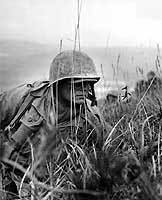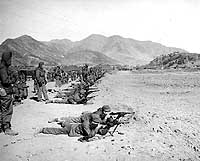
The weeks following 25 November 1950 formed one of the most miserable periods of U.S. military history. What on 24 November promised the conflict's early and victorious end was swiftly transformed into an "entirely new war", with UN (overwhelmingly American) and Republic of Korea troops fighting for their lives through Communist Chinese ambushes and roadblocks in the midst of wintery weather that often inflicted more casualties than did the enemy.
The Chinese proved themselves masters of infiltration, evading premature observation by moving mainly at night, skillfully covering their tracks and taking full advantage of the UN/ROK armies' thinly-manned front, roadbound tactics and inadquate patrolling. Not for the first time, nor for the last, superior air power was unable to detect and stop an enemy's buildup before he chose to engage. Even after the Chinese were out in the open, bad weather frequently curtailed air support.
On 29 November, General MacArthur ordered withdrawal on all fronts. In the west, the Eighth Army broke contact and retired rapidly through Pyongyang, which was abandoned on 5 December. The nearby port of Chinnampo, opened only a month before, was evacuated by sea on 4-6 December, providing a way out for many supplies and refugees.
In the east, X Corps was ordered to fall back on the port of Hungnam. Ships pulled some units out of Songjin and Wonsan, while others moved by road. To the North, on 1-4 December, the First Marine Division shot its way down from Yudam-Ni, west of the Chosin Reservoir, to Hagaru, at its base. Covered by Marine and Navy planes, it continued the fight down the road from Hagaru to Hungnam, completing the movement on 10-11 December. A general evacuation of Hungnam then commenced, taking the Marines and most other evacuated forces to Pusan to regroup.
After a lull of some weeks, the Chinese offensive was renewed as 1950 ended. Seoul was given up on for the second time on 4 January and a new defensive line established running across Korea well south of the city. With the evacuation of Inchon the UN Command was again left with Pusan as its only major seaport.
However, the Chinese soon exhausted their offensive push. They had lost a large proportion of their men, and their now extended supply line, subject to intense bombardment from the air, sea and ground, was unable to sustain attacks. Directed by a new and energetic commander, Lieutenant General Matthew B. Ridgway, in mid-January the Eighth Army (now including the previously independent X Corps) probed northwards, finding little of the enemy. On 25 January, a cautious general advance began, the first of a series that would ultimately stabilize the front beyond the old line between North and South Korea.
This page features pictures of and related to land operations during the Chinese offensive period of the Korean War, from 25 November 1950 to 25 January 1951.
For visual coverage of other aspects of the November 1950
- January 1951 Chinese offensive in Korea, see:
For a precis of our Korean War images, and links to more
comprehensive pictorial coverage of that conflict, see:
| If you want higher resolution reproductions than the Online Library's digital images, see: How to Obtain Photographic Reproductions. |
Click on the small photograph to prompt a larger view of the same image.
|
Photo #: NH 97032 "Leathernecks inch forward under fire on the central Korean front" Quoted from the original photo caption. This view was taken in late 1950 or early 1951, and was published in "All Hands" magazine's May 1951 issue. Note scarf worn around the neck of this Marine and billed cap under his helmet. Photographed by Cpl. W.T. Wolfe, USMC. Official U.S. Marine Corps Photograph, from the "All Hands" collection at the Naval Historical Center. Online Image: 87KB; 600 x 765 pixels |
 |
|
Photo #: NH 97023 Chosin Reservoir Campaign, November-December 1950 "Weapons Company, in line with Headquarters and Service Company, 2nd Battalion, 7th Marines, trying to contact the temporarily cut off Fox Company in a glancing engagement to permit the 5th and 7th Marines to withdraw from the Yudam-ni area. Nov. 27, 1950." Quoted from original picture caption, released by Headquarters, U.S. Marine Corps, on 22 December 1950. Yudam-ni, at the western extremity of the Chosin Reservoir, was the scene of early combat in the campaign, as Chinese forces attacked the two Marine regiments there. The Marines subsequently had to fight their way back to Hagaru along roads surrounded by the enemy. Official U.S. Marine Corps Photograph, from the "All Hands" collection at the Naval Historical Center. Online Image: 107KB; 740 x 615 pixels |
 |
|
Photo #: 80-G-424768 Rear Admiral James H. Doyle, USN, Commander Task Force 90, Major General Field Harris, USMC, Tactical Air Commander for Tenth Corps, and Lieutenant General Lemuel C. Shepherd, Jr., USMC, Commanding General Fleet Marine Force Pacific. Confer at Yonpo airfield, near Hungnam, North Korea, on 8 December 1950, shortly before the Hungnam Evacuation was undertaken. Note planes in the background, including a F7F "Tigercat" (at left) and F4U "Corsairs". Official U.S. Navy Photograph, now in the collections of the National Archives. Online Image: 84KB; 740 x 605 pixels Reproductions of this image may also be available through the National Archives photographic reproduction system. |
 |
|
Photo #: NH 97024 First Marine Division in Korea Marines "brushing up on marksmanship somewhere in Korea". Photo probably taken about New Year's Day, 1951, following the withdrawal from North Korea to the Pusan area. It was published in "All Hands" magazine's March 1951 issue. Marines in the foreground are firing M1 carbines. Most of those further up the line have M1 rifles. Official U.S. Marine Corps Photograph, from the "All Hands" collection at the Naval Historical Center. Online Image: 125KB; 740 x 620 pixels |
 |
|
Photo #: NH 97025 Seventh Marine Regiment in Korea Tug of war contest during "New Year 'Fun Day' competition held at the rest camp of the Seventh Marine Regiment, somewhere in Korea, 1951. These were the men who went into action against Chinese communists in North Korea Nov.2, and later led the breakout to Hamhung on December 10." Quoted portions are from the original picture caption. This rest camp was probably in the the Pusan area. Official U.S. Marine Corps Photograph, from the "All Hands" collection at the Naval Historical Center. Online Image: 134KB; 740 x 620 pixels |
 |
For visual coverage of other aspects of the November 1950
- January 1951 Chinese offensive in Korea, see:
For a precis of our Korean War images, and links to more
comprehensive pictorial coverage of that conflict, see:
| If you want higher resolution reproductions than the Online Library's digital images, see: How to Obtain Photographic Reproductions. |
11 August 2000